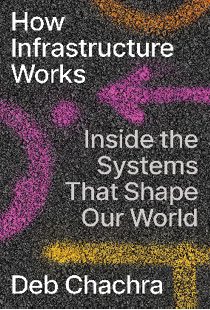Book Review: “How Infrastructure Works,” By Deb Chachra

Reviewed by Angus Stocking
A much longer and more detailed review can be found online at bit.ly/3ThIJmM or by scanning the accompanying QR code.
Deb Chachra’s “How Infrastructure Works” is a bestseller released to wide acclaim in late 2023. Adulation by the literary class isn’t necessarily a strong recommendation for infrastructure professionals, but on reading Chachra’s book, I find it’s indeed an information-rich and important contribution to infrastructural theory. And as a lifelong, self-described fan of “charismatic megainfrastructure” with unimpeachable academic credentials, Chachra speaks with authority.
Chachra’s ultimate aim is to encourage paradigm change in infrastructure planning and thinking, particularly in the domain of energy production. She marshals technological, social and philosophical arguments to make her case, and I believe the professionals who read Informed Infrastructure should consider these carefully and decide for themselves if she’s onto something.
Infrastructure As Agency and ‘Birthright’
In opening chapters, Chachra speaks of infrastructure systems as something like mecha suits enabling relatively frail humans to summon clean water at will, whisk away sewage and garbage, talk to anyone anywhere and fly at rocket speed wherever we desire, all by calling on regional or global infrastructure networks … if we happen to live in a part of the world with good infrastructure.
“We now live surrounded by technological systems of nearly unimaginable scale, extent and complexity,” she writes. “It took me a shockingly, embarrassingly long time to recognize the inequity that is baked into nearly every one of these facilities and systems.”
“Equity” invites division in some quarters, but Chachra’s call for infrastructure equity seems to sidestep controversy—surely we can all agree that the world’s people should enjoy the luxury of access to the aforementioned individual agency. However, the “infrastructural birthright” that grants this agency already is an accomplished fact for a portion of humanity, and a desire for such agency to be accomplished globally strikes me as the least problematic of charitable urges. And, as a species, we’re already heading in that direction.
It’s true that existing infrastructural networks can be, according to the author, “fairly described as vast constructions whose purpose is to centralize resources and agency to a small fraction of extremely privileged humans and to displace the harms to many others.” And yet it’s also true that what “makes networks special is not just that they’re collective but that they can also be synergistic: the more people who use them, the more valuable they become for everyone … every community, home or business that is connected to a road or telephone network makes the whole network more valuable for everyone on it.”
Moreover, many of these “vast constructions” already are transnational or global and governed by internationally applied standards and agreements; the North American electric grid and international shipping of intermodal containers are examples.
Chachra argues that infrastructural uplift of all humans isn’t only the most altruistic of collective pursuits, but perhaps also the cheapest and most-efficient way to make everyone happy.
A Grand Vision for the Built World
“For most of human history, access to energy has enabled or limited what’s possible,” Chachra writes and then asks: “What would it take for every human on the planet to use about the same amount of energy as I do, in my warm, well-lit home, with fuel for cooking on tap, and access to mobility options including a personal vehicle, mass transit, and air travel?”
A credible calculation results in the figure 2.4 * 1021 joules per year, roughly 10 times the current global energy consumption. An impossibly large amount of energy to produce, of course, except that the Sun “bathes our planet in radiant light and warmth to the tune of about 5.5 * 1024 joules each year.”
Energy production meeting the needs of every human on Earth is just 0.04 percent of incipient solar radiation. Of course, making the change to combustion-free energy production is a big task, but Chachra points out that “renewable energy is now where electricity itself was a century and a half ago: the technologies are still somewhat emergent, with some unresolved questions, and they’re still only a small part of energy systems.” She unhesitatingly includes nuclear power and gigantic hydro and geothermal facilities as examples of best practice in power production.
Refreshingly, Chachra implicitly rebukes globalist calls for reduced energy consumption by a reduced human population, and I appreciate her frank recognition that any attractive future for human civilization must be enabled by cheap, sustainable energy for all and widely distributed resilient infrastructure.
“How Infrastructure Works” gives me rational hope for a better world, and for that I’m grateful.

About Angus Stocking
Angus Stocking is a former licensed land surveyor who has been writing about infrastructure since 2002 and is the producer and host of “Everything is Somewhere,” a podcast covering geospatial topics. Articles have appeared in most major industry trade journals, including CE News, The American Surveyor, Public Works, Roads & Bridges, US Water News, and several dozen more.


